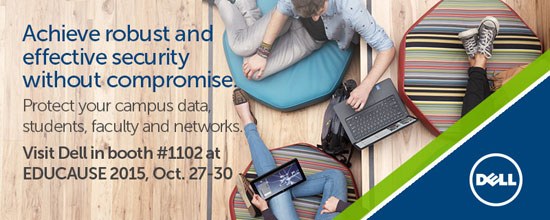Digital natives predominantly compose the student body at today’s higher education institutions, and technological advancements have created unprecedented opportunities for personalized learning. BYOD and other emerging technologies have allowed schools and universities to become more effective, inclusive, and collaborative.
With the proliferation of devices now on the network, however, IT administrators are now faced with the enormous task of empowering end-users to capitalize on the benefits of increased mobility and connectivity, while also ensuring the integrity of the organization’s network and data. In our current threat environment, it is more critical than ever that colleges and universities develop an overarching, end-to-end security approach that aligns with the institution’s mission.
A recent Dell survey, conducted in partnership with the Center for Digital Education, targeted higher education IT professionals, including executives (CIO, CISO, VP of IT, etc.), IT Directors and network managers to assess the state of network security on college campuses. A key takeaway from the study, however unsurprising, is that 73 percent of respondents rank cybersecurity high or very high among their institution's technology priorities.
Just as cybersecurity has become a priority across industry and government, higher education institutions are shining a brighter spotlight on security – and for good reason. While educational institutions rank their ability to detect and block cyber attacks relatively high, with 65 percent citing their abilities as good or excellent, only 17 percent indicate that they have not experienced a network breach/incident in the past year. This statistic is indicative of the fact that cyber threats are continuing to increase in both frequency and sophistication in every industry.
In response to the growing threat of data breaches, 77 percent of survey respondents indicate they expect to spend more on network security in the next 12 months and 63 percent expect to spend more on secure access to data and applications. This is an encouraging statistic, as it reflects increased awareness around the need to strengthen security and mitigate risk.
In our hyper-connected world, a strong security posture is a strategic investment for higher ed. IT administrators and decision makers across the education industry need to address the continually growing role of technology on campus by implementing end-to-end security solutions that protect all data and endpoints, old and new. Holistic, end-to-end security that utilizes identity access management, next-gen firewalls, endpoint security and efficient patch management allows colleges and universities to confidently and securely offer the benefits of increased mobility and other IT advances to its faculty and students.
Join us at the 2015 EDUCAUSE Annual Conference to explore strategies to secure campuses, staff and students. On October 28, Dell will present a session titled, “Enable Better Student Outcomes Without Sacrificing Security,” where EDUCAUSE attendees will have the chance to hear from Kim Cary, CISO, Pepperdine University about how his organization has implemented end-to-end security.


